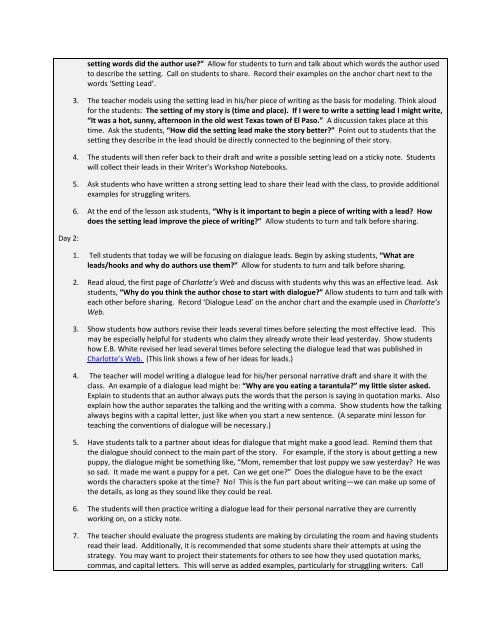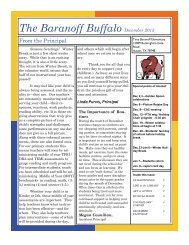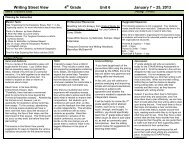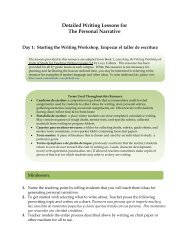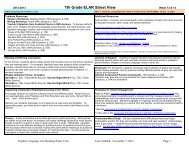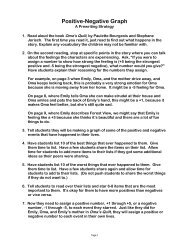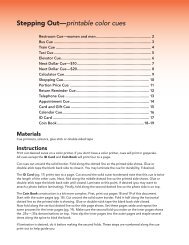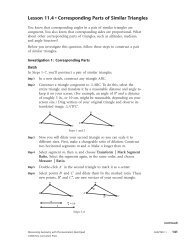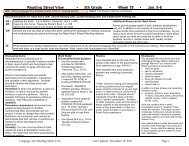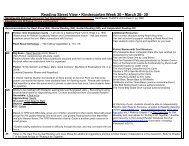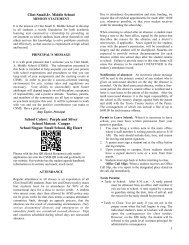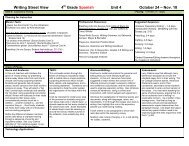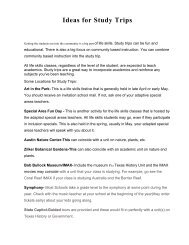Lesson Template 12-13
Lesson Template 12-13
Lesson Template 12-13
You also want an ePaper? Increase the reach of your titles
YUMPU automatically turns print PDFs into web optimized ePapers that Google loves.
Day 2:setting words did the author use?” Allow for students to turn and talk about which words the author usedto describe the setting. Call on students to share. Record their examples on the anchor chart next to thewords ‘Setting Lead’.3. The teacher models using the setting lead in his/her piece of writing as the basis for modeling. Think aloudfor the students: The setting of my story is (time and place). If I were to write a setting lead I might write,“It was a hot, sunny, afternoon in the old west Texas town of El Paso.” A discussion takes place at thistime. Ask the students, “How did the setting lead make the story better?” Point out to students that thesetting they describe in the lead should be directly connected to the beginning of their story.4. The students will then refer back to their draft and write a possible setting lead on a sticky note. Studentswill collect their leads in their Writer’s Workshop Notebooks.5. Ask students who have written a strong setting lead to share their lead with the class, to provide additionalexamples for struggling writers.6. At the end of the lesson ask students, “Why is it important to begin a piece of writing with a lead? Howdoes the setting lead improve the piece of writing?” Allow students to turn and talk before sharing.1. Tell students that today we will be focusing on dialogue leads. Begin by asking students, “What areleads/hooks and why do authors use them?” Allow for students to turn and talk before sharing.2. Read aloud, the first page of Charlotte’s Web and discuss with students why this was an effective lead. Askstudents, “Why do you think the author chose to start with dialogue?” Allow students to turn and talk witheach other before sharing. Record ‘Dialogue Lead’ on the anchor chart and the example used in Charlotte’sWeb.3. Show students how authors revise their leads several times before selecting the most effective lead. Thismay be especially helpful for students who claim they already wrote their lead yesterday. Show studentshow E.B. White revised her lead several times before selecting the dialogue lead that was published inCharlotte’s Web. (This link shows a few of her ideas for leads.)4. The teacher will model writing a dialogue lead for his/her personal narrative draft and share it with theclass. An example of a dialogue lead might be: “Why are you eating a tarantula?” my little sister asked.Explain to students that an author always puts the words that the person is saying in quotation marks. Alsoexplain how the author separates the talking and the writing with a comma. Show students how the talkingalways begins with a capital letter, just like when you start a new sentence. (A separate mini lesson forteaching the conventions of dialogue will be necessary.)5. Have students talk to a partner about ideas for dialogue that might make a good lead. Remind them thatthe dialogue should connect to the main part of the story. For example, if the story is about getting a newpuppy, the dialogue might be something like, “Mom, remember that lost puppy we saw yesterday? He wasso sad. It made me want a puppy for a pet. Can we get one?” Does the dialogue have to be the exactwords the characters spoke at the time? No! This is the fun part about writing—we can make up some ofthe details, as long as they sound like they could be real.6. The students will then practice writing a dialogue lead for their personal narrative they are currentlyworking on, on a sticky note.7. The teacher should evaluate the progress students are making by circulating the room and having studentsread their lead. Additionally, it is recommended that some students share their attempts at using thestrategy. You may want to project their statements for others to see how they used quotation marks,commas, and capital letters. This will serve as added examples, particularly for struggling writers. Call


